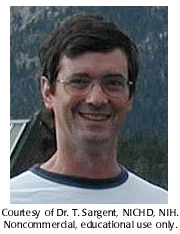Concept 36 Different genes are active in different kinds of cells.



 Igor Dawid and Tom Sargent did some of the first differential gene expression studies using cDNA subtraction. Pat Brown and Steve Fodor have changed the way genomes can be screened with DNA arrays and GeneChips®
Igor Dawid and Tom Sargent did some of the first differential gene expression studies using cDNA subtraction. Pat Brown and Steve Fodor have changed the way genomes can be screened with DNA arrays and GeneChips®
Thomas Dean Sargent (1953-)

Tom Sargent was born in Indianapolis, Indiana, (the same year as DNA). As a child he was always interested in science. When he was twelve years old, a family friend gave him the first edition of James Watson's textbook Molecular Biology of the Gene. Sargent pored over the text for months studying concepts that were meant for college-level students.
Sargent found biology so fascinating he majored in the subject at Indiana University. When he graduated he went to the California Institute of Technology for graduate work. During this time, gene cloning was a "new" technology and the arrival at Caltech of Tom Maniatis, who was the first to clone a mammalian gene, inspired many graduate students including Sargent to switch to gene cloning projects. Sargent finished his Ph.D. in 1981 by cloning and characterizing a rat serum albumin gene.
While at Caltech, Sargent and others, including Mark Davis and David Cohen, became interested in differential gene expression. For post-doctoral work, Sargent looked for an organism where he could easily make libraries of genes that were being expressed at different times in development. He sat in on a talk by Igor Dawid who was using frog embryos to study development. Sargent approached Dawid who hired him immediately as a post-doc. They developed the subtractive library system using frog mRNAs almost concurrently with Davis and Cohen, who used a similar method to look at T-cell specific gene expression. Sargent and Dawid published their results first. However, because so few genes had been cloned at the time, there weren't very many identifiable clones in their library; there were a number of "unknowns" and some epidermal keratin genes. Since then, the "unknowns" have been identified as being homeobox and other types of regulatory genes. Sargent has been and still works on epidermal development - the first tissues to form in frogs.
Sargent is currently Chief Research Microbiologist in the Section on Vertebrate Development in the Laboratory of Molecular Genetics, NICHD, NIH. He also teaches genetics at George Washington University. In his spare time, Sargent indulges in his hobby of wood-working.


GeneChip® technology is sensitive enough to detect single base pair differences, though the hybridization conditions must be ideal.

A-T pairs have two hydrogen bonds and G-C pairs have three. How would this affect the binding of DNA onto GeneChip® especially if the single nucleotide difference is an A to a G?
 DNA is packaged in a chromosome.
DNA is packaged in a chromosome. Higher cells incorporate an ancient chromosome.
Higher cells incorporate an ancient chromosome. Some DNA does not encode protein.
Some DNA does not encode protein. Some DNA can jump.
Some DNA can jump. Genes can be turned on and off.
Genes can be turned on and off. Genes can be moved between species.
Genes can be moved between species. DNA responds to signals from outside the cell.
DNA responds to signals from outside the cell. Different genes are active in different kinds of cells.
Different genes are active in different kinds of cells. Master genes control basic body plans.
Master genes control basic body plans. Development balances cell growth and death.
Development balances cell growth and death. A genome is an entire set of genes.
A genome is an entire set of genes. Living things share common genes.
Living things share common genes. DNA is only the beginning for understanding the human genome.
DNA is only the beginning for understanding the human genome.